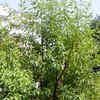
While we were busy arguing about fate versus free will, duty versus desire, dharma versus self-interest, these plants were quietly standing witness—absorbing war cries, whispered prayers, and the unfiltered truth of human nature. And yet, they didn’t just survive. They became symbols. Of clarity, of resilience, of understanding what matters when everything else fades. So, before you fill your room with aesthetic but utterly meaningless décor, maybe—just maybe—you need something that carries wisdom in its roots.
1. Tulsi

Purifies air, enhances clarity, and symbolizes devotion.
Let’s get one thing straight: Tulsi is not just a plant. It’s a
presence. No other plant in Indian culture gets its own pedestal, daily offerings, and whispered reverence like this one. Even Krishna—the cosmic strategist, the guy who literally
wrote the playbook on divine intervention—held Tulsi in the highest regard.
Why? Because Tulsi doesn’t just cleanse the air; it cleanses the
mind. It’s a plant that reminds you to recalibrate. It doesn’t demand your attention like a fragile indoor fern. It just
is. Steady, healing, quietly doing what needs to be done. If that’s not a life lesson, I don’t know what is.
2. Peepal

Represents wisdom, patience, and historical significance.
There are trees, and then there’s Peepal. This isn’t just a tree; it’s a record-keeper. Every rustling leaf has likely heard a story it’ll never repeat. Vyasa, the one who wrote the Mahabharata, is said to have meditated under it. Krishna, in the Bhagavad Gita, flat-out says,
Of all trees, I am the Peepal.
But here’s why you need it: the Peepal doesn’t just exist—it
teaches. It grows where it wants, thrives without permission, and watches centuries go by without losing itself. Place it in your space—not just for oxygen (though it gives that in abundance) but for perspective. Life isn’t about reacting to every passing storm. It’s about understanding which ones are worth your energy.
3. Sandalwood

Promotes calmness, spiritual energy, and mental peace.
The world burns, people lose their minds over minor inconveniences, but Sandalwood? It stays cool. Literally. You rub its bark, and instead of heat, it releases a fragrance so calming that it’s used in temples, meditation, and stress relief rituals.
It doesn’t just smell divine; it
reminds you to be divine. To not let external chaos dictate your internal state. To stay rooted in who you are, no matter who or what tries to change you. If you’ve ever wanted a life philosophy summed up in a plant, this is it.
4. Ashwattha

Symbolizes higher consciousness, divine knowledge, and perspective.
The Ashwattha tree, also known as the sacred fig, is not just mentioned in the Mahabharata—it gets a full-blown existential shoutout in the Bhagavad Gita. Krishna describes it as a tree whose
roots are above, and branches are below. Which, if you think about it, is exactly how life works.
We’re all trying to make sense of things from the ground up, but the real truth—the real understanding—is rooted in something higher. This tree doesn’t just grow; it
questions growth. It forces you to think beyond the visible, beyond what’s easy to explain. If you’re the kind of person who looks at the night sky and wonders
why we’re here, this one’s for you.
5. Bamboo

Teaches adaptability, resilience, and inner strength.
Bamboo is the most underestimated powerhouse in nature. It bends but doesn’t break. It grows fast, but never chaotically. It’s strong but flexible, proving that resilience isn’t about being rigid—it’s about adapting without losing yourself.
Draupadi, the woman who held the entire Mahabharata together with sheer willpower, was Bamboo in human form. She adapted, she endured, and when the moment came, she stood taller than every man who underestimated her. If you need a plant that doesn’t just sit in a corner looking pretty but actually
reminds you how to handle life, Bamboo is it.
Why This Matters
You don’t need another decorative item in your room. You need something that
means something. These plants aren’t just good for aesthetics. They are living philosophies, reminders of what lasts when everything else falls apart.
Tulsi teaches devotion.
Peepal teaches patience.
Sandalwood teaches calm.
Ashwattha teaches perspective.
Bamboo teaches resilience.
The Mahabharata isn’t just an old story—it’s
our story, still playing out in different forms, in different lives. The characters changed. The lessons didn’t. Maybe it’s time we stopped thinking of plants as just décor and started seeing them for what they are—silent guides in a very, very noisy world.
 While we were busy arguing about fate versus free will, duty versus desire, dharma versus self-interest, these plants were quietly standing witness—absorbing war cries, whispered prayers, and the unfiltered truth of human nature. And yet, they didn’t just survive. They became symbols. Of clarity, of resilience, of understanding what matters when everything else fades. So, before you fill your room with aesthetic but utterly meaningless décor, maybe—just maybe—you need something that carries wisdom in its roots.
While we were busy arguing about fate versus free will, duty versus desire, dharma versus self-interest, these plants were quietly standing witness—absorbing war cries, whispered prayers, and the unfiltered truth of human nature. And yet, they didn’t just survive. They became symbols. Of clarity, of resilience, of understanding what matters when everything else fades. So, before you fill your room with aesthetic but utterly meaningless décor, maybe—just maybe—you need something that carries wisdom in its roots.




